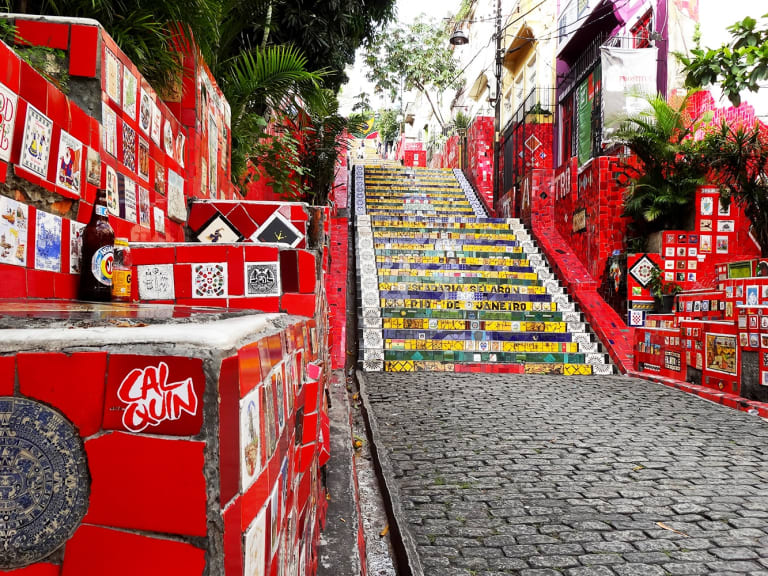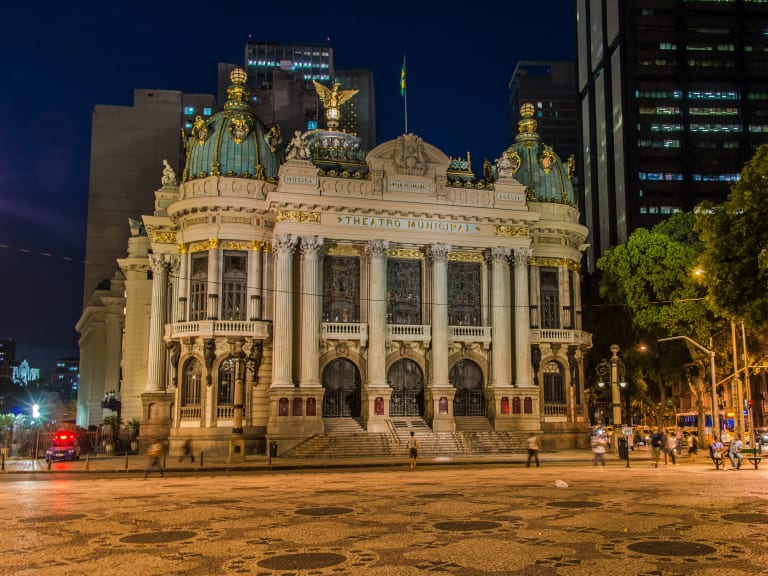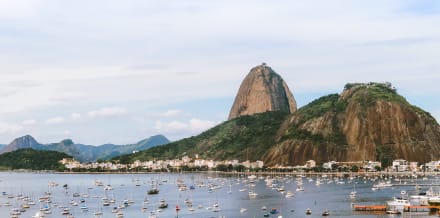More about: Rio de Janeiro in 3 Days: a guidebook for getting the most out of your visit
Rio de Janeiro is a charming city, well worth spending a couple of days in. Here you can enjoy a vacation of disconnection, strolling through authentic streets, quaint cafes and modern buildings. In three days you can take advantage of the best things to do in the region, such as entering a museum with interactive installations, climbing the Sugarloaf Mountain or watching a carnival parade in the City of Samba.
Note that the best transportation options for getting around are cabs, buses and subways. In general, you will be able to walk around the historical center, explore the port area and discover the main monuments. I have prepared an itinerary, so you can optimize your time and get the best perspective of Rio de Janeiro in a short time.
Day 1: Explore the Historic Center of Rio de Janeiro

The Historic Center of Rio de Janeiro is an area full of nuances and contrasts, characterized by rows of colonial buildings and other more modern monuments. It is worth spending at least a day there, as it has more than 500 years of history. There are always tourists, in fact in some places there is a queue to enter, so I recommend you start the day very early. To get around I suggest walking or using the subway, if you prefer to go comfortably cabs are a good option.
Selarón Staircase
To start the tour you can start by visiting the Selarón Staircase, a creative and bohemian monument located between the vibrant streets of Santa Teresa and Lapa neighborhoods. There are 215 steps with icons, phrases and stories engraved on tiles representing more than 70 countries. It is a kind of abstract mural that was built by Chilean artist Jorge Selarón in 1947.
As you go up you will see tiles of soccer teams, different types of birds, celebrities and more. In addition, there is a repeated image of a pregnant African woman, which is a complete mystery that was part of Selarón's past. Also, if after a day of sightseeing you are looking for things to do in Rio de Janeiro at night, you can go up here and enjoy the nightlife in Lapa.
Lapa Arches
Next stop is the Lapa Arches, a monument that you can reach from the Selarón Stairs by cab in less than twelve minutes. You can also get there in less than six minutes using the local bus, although I don't recommend it during rush hour. It is an important work in the carioca architecture that belongs to the colonial period, the most interesting thing is that it has 42 Roman style arches that support the structure.
Here you can take pictures for the memory, or wait for the streetcar or bondinho de Santa Teresa a characteristic transport of the Portuguese culture. Overall, it is a very short but worthwhile stop as it was once the main aqueduct of the city.
Real Gabinete Portugués de Lectura
From the Arco de Lapas to the Real Gabinete Português de Lectura is a nine-minute drive, but you can also take the bus or walk along Av. República do Paraguai. This is a library whose architecture has elements of the Gothic and Italian Renaissance periods. It was inaugurated by the Brazilian royal family and houses books that belonged to the monarchy. It has more than 350,000 copies, some dating from the sixteenth and seventeenth centuries.
I recommend passing through the Great Reading Room, illuminated by natural light from the central skylight. Here you can walk through the bookshelves, chandeliers and stairs that interconnect the building. It is one of the best things to do in Rio de Janeiro, as it is completely free and operates from Monday to Friday from 9:00 a.m. to 6:00 p.m.
Colombo Confectionery
There is still a lot to see in the historic center of Rio de Janeiro, for example you can leave behind the Royal Portuguese Reading Cabinet and head down R. do Ouvidor to the Colombo Confectionery. It is a coffee shop more than a century old, founded in 1894, located on the picturesque little street Gonçalves Dias. The decoration revolves around preserved elements of the period, such as the stained glass ceiling, floor tiles and Belgian mirrors on the walls.
The construction was the work of Portuguese immigrants and throughout history has received celebrities, such as Queen Elizabeth of England. At the top you can access a terrace with panoramic views of the entire city. Additionally, three minutes away is Casa Cave, the oldest confectionery, founded by a Frenchman in 1860. It is a less crowded option, since the Confiteria Colombo usually has a long queue. Undoubtedly, it is the perfect place to end your day and get to know the local gastronomy.
Day 2: Visit the Olympic Boulevard, the Museum of Tomorrow, the City of Samba, the Ethnic Mural and climb to the highest part of Rio de Janeiro

The Olympic Boulevard is the port area of the city, where some of the best museums in Rio de Janeiro are located. There is also an artistic mural, where the main component is cultural diversity. From here you can go up in the late afternoon to Sugarloaf Mountain to enjoy the panoramic views.
Museum of Tomorrow
The Museum of Tomorrow is a neuro futuristic space that focuses on ecology, sustainability and the future of planet earth. It was built by Spanish architect Santiago Calatrava and is very close to the sea, so it is an ideal location to start the day as there are few tourists. I recommend spending at least an hour to know its interior, it is open from Tuesday to Saturday from 10:00 a.m. to 5:00 p.m.
You can travel back in time taking advantage of its interactive facilities, games and audiovisual attractions. You can even see a simulation of the Big Bang, as well as the changes that mankind has undergone during its evolution. You can also explore other technological advances and the history of the universe in the Cosmos, Earth, Anthropocene, Mornings and Now sections.
Samba City
Rio de Janeiro is famous for its fun carnivals, on the BoulevardOlympico you are sure to come across samba shows on the street. However, there is a special place to soak up the Carioca culture. It is located six minutes from the museum by cab, there are also subways and buses that have routes in the area. Samba City is a complex of buildings housing the most important samba schools in the region.
If you plan to visit the city at the beginning of the year, you may encounter parades and the election of the Carnival Queen. It is one of the best things to do in Rio de Janeiro, in fact you can witness the carnival shows at the samba schools, as practices are organized all year round. It is the perfect plan to dance samba carioca and soak up the local culture.
Ethnic Mural
The Mural of Ethnicities or We Are All Um is an imprint left in the city, as a reminder of the Rio 2016 Olympic Games. It measures approximately 3,000 square meters and is a work of Brazilian artist Eduardo Kobra. It is famous for being the largest graffiti in the world, so it is a must stop during your stay in Brazil. When you look closely, you will see faces representing the native peoples of different continents.
Specifically, they are the five rings of the Olympics showing the communities of Huli (Oceania), Mursi (Africa), Kayin (Asia), Supi (Europe) and Tapajós (America). It is one of the most interesting points of the port area, where you can take pictures to remember. The best tours of Rio de Janeiro usually include this stop and also allow you to know the history in detail. This mural is an eight-minute cab ride from Samba City, but there is also a bus line that connects both locations.
Sugar Loaf
To relax at the end of the afternoon, you can climb the Sugar Loaf located thirty minutes from the Mural of Ethnicities. Leaving the Olympic Boulevard behind, you can discover an interesting rock on the heights of Rio de Janeiro. Specifically, it is located at the entrance of Guanabara Bay and is a famous Brazilian landmark that you cannot miss.
You can ride the cable car up the hill and enjoy the panoramic views, as well as make a quick stop at Morro de Urca, where there are souvenir stores. When you get to the top you can try the traditional caipirinha, an alcoholic drink that will keep you warm. You can also reach the top by climbing or trekking. It is a very busy place, so I recommend booking your tickets to Rio de Janeiro's Sugarloaf in advance.
Day 3: Visit the Municipal Theater, San Sebastian Cathedral, the Flamenco Museum, Maracana Stadium and Christ the Redeemer.

There are still many things to see and do in the city, as the entertainment offer is wide. You cannot miss one of the best museums in Rio de Janeiro, known as the Flamenco Museum. In addition, between downtown and the port area you will have the opportunity to pass by the Municipal Theater, the Metropolitan Cathedral and the Maracana Stadium.
Municipal Theater
Another historical building you can't miss is the Municipal Theater, a place with an impressive architecture, where some of the best activities in Rio de Janeiro take place, such as ballets, opera shows, plays and more. Thiscultural stop will take you to see a local landmark built around 1905.
Concerts are also organized, as well as guided tours of the facilities from 4 euros per person. The advantage of walking the corridors of this building with a professional is to know its history and the main function of each space. In the Municipal Theater you can take a look at the main hall and its lobby, where stained glass and Venetian mosaics abound with details of onyx, bronze and marble. If you want something to eat, you can approach the restaurant whose facade has statues inspired by the ancient city of Persepolis.
San Sebastian Cathedral
Five minutes from the theater, you will find the Metropolitan Cathedral of Rio de Janeiro or the Cathedral of San Sebastian. It has a particular facade in the shape of a pyramid, without dome or bell tower. I recommend you to visit the subway part, where the museum that houses the history of this emblematic building is hidden. If you go by car, you can take advantage of the parking that is available around the clock.
You can visit it from 7:00 a.m. to 5:00 p.m., free of charge and explore the brightly colored stained glass windows that are in different spaces of the building. Note that it is the oldest cathedral in Rio de Janeiro and has a capacity of approximately 20,000 people. It houses the throne of Dom Pedro II, the baptismal font of the Brazilian royal family and objects from Pope John Paul II's visit to the country.
Flamenco Museum
To close the first day, you can appreciate the Flamenco Museum located less than twenty-five minutes from the cathedral. Since it is usually rush hour in the afternoon, I recommend taking a cab as the museum is open Tuesday through Saturday from 10:00 am to 5:00 pm. Here you will find the collection of the Flamengo soccer club: one of the best known Brazilian teams, where soccer fans will have a great time.
In the facilities you will find trophies, jerseys and photographs, you can tour it on your own or book a guided tour from 22 euros, where you will learn about the history of the team. The Flamengo Club also has other disciplines with an interesting history, such as swimming, water polo, tennis, basketball, volleyball, artistic gymnastics, wrestling and more.
Maracana Stadium
A visit to the Maracana Stadium, considered the city's soccer temple, is a must in your itinerary. It is an icon of the region, where Rio de Janeiro's soccer activities take place. I recommend you to visit it, since soccer stars such as Pelé and Ronaldo have played in the stadium, as well as artistic events of The Rolling Stone, Frank Sinatra, Madonna and more.
If you are looking for things to see and do in Rio de Janeiro in August, I suggest you take advantage of a guided tour of its facilities: specifically from February to August is the national soccer season. On this tour you will be able to see the locker rooms, press room and more. Keep in mind that getting from the museum to the stadium will take you approximately twenty-five minutes by cab.
Christ the Redeemer
To end the day, nothing better than going up to one of the most emblematic sites in Rio de Janeiro: Christ the Redeemer. It is a very special monument located at the top of Corcovado hill, offering breathtaking views. The main attraction is the statue that protects the Carioca city elevated at 710 meters above sea level, however you can also visit the Botanical Garden that has native species and flora brought from West India.
This place is located thirty minutes away from the Maracana Stadium, the best options to climb on foot through the trails, by minivan, taking advantage of the best tours to Christ the Redeemer or through the cog railway. The Corcovado train is a fast and safe adventure ideal if you are traveling with your family, which will allow you to visit at your own pace and without queues. You will be able to see the city from different angles for around 30 euros.




